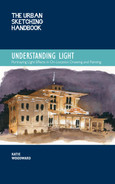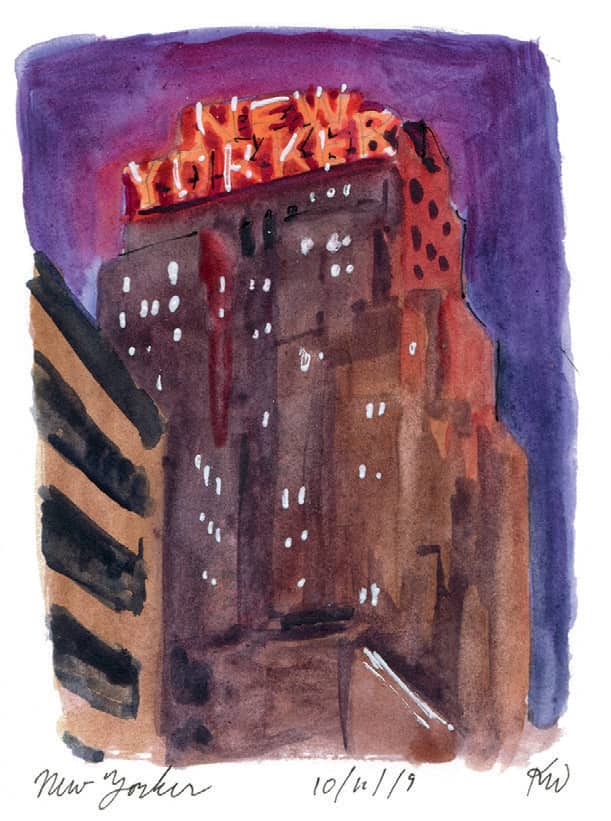
KEY VI
NIGHT SCENES
Night scenes turn lighting on its head as local color becomes nearly irrelevant. We know there are big fluctuations in our perception of local color as the sun moves during the day. At night this is exacerbated by a general lack of light punctuated by very specific light sources. As it gets darker, the cones in our eyes responsible for perceiving color have a harder time doing their job, so you may notice that colors around you appear more neutral as light dims. Colors that appear vibrant and high chroma in full light may slowly fade to gray as the sun sets and they become harder to see. This can make well-lit areas appear even more colorful by comparison, or you may just have amber glowing windows. In addition to color being less straightforward, and we are likely to encounter a number of different light sources, all of which may have differing colors and qualities. The good news is, there are lots of ways to simplify a scene and dial in what we see before us so we can tackle these scenes with abandon!
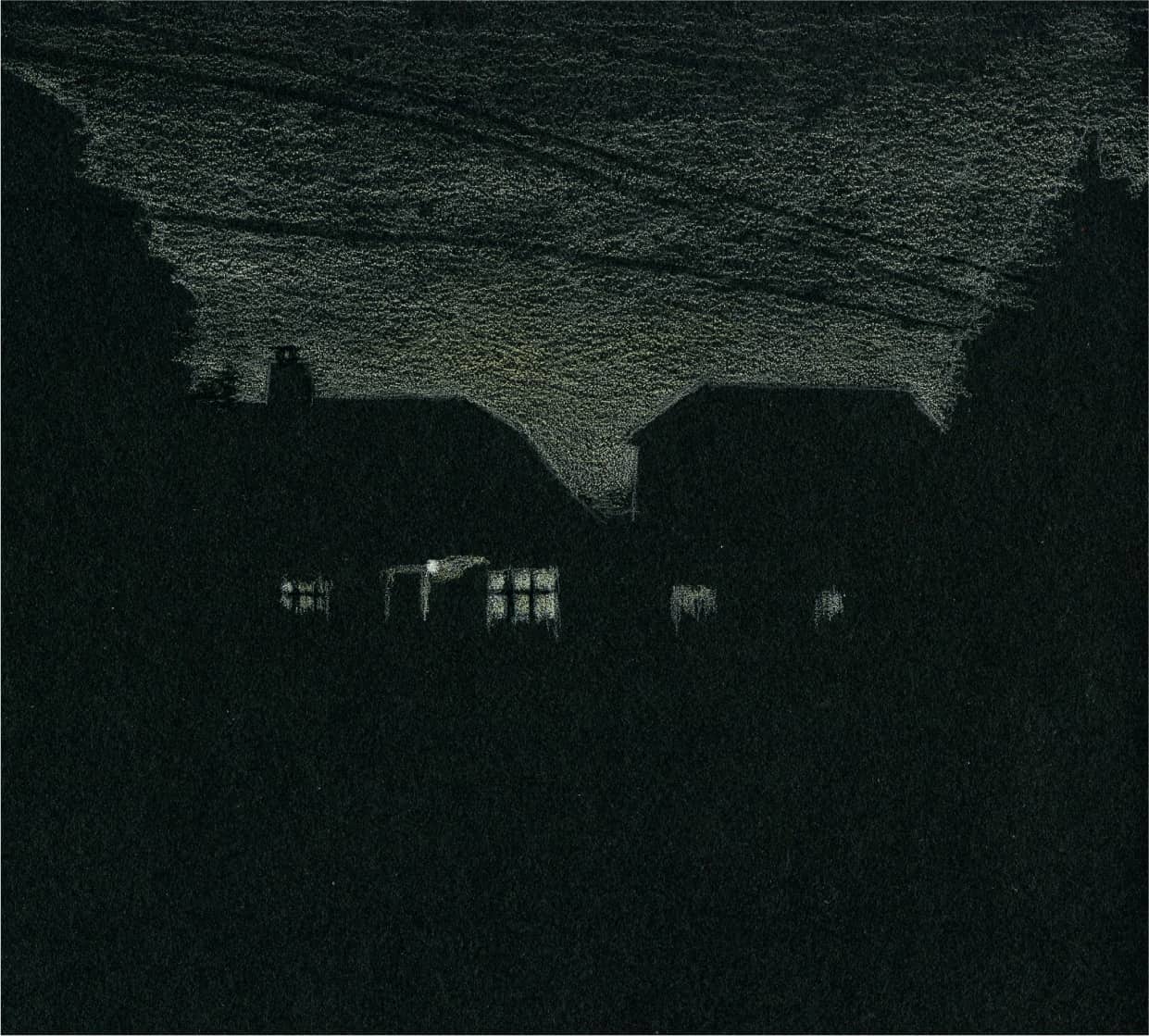
TINA KOYAMA
Predawn on Thanksgiving, Seattle, Washington
7" x 7" | 17.8 x 17.8 cm; colored pencils, black paper; 40 minutes
MULTIPLE LIGHT SOURCES
A common light source for nighttime scenes is the light filtering through windows, as seen from outside. Often the quality of light is warm and soft, from multiple light sources or even the light of one lamp bouncing around the white walls of a room before it makes its way outside. The escaping light may have a slight corona if you want it to feel especially glowy. Light exiting a door or window on the ground level may hit street level objects and you may see the light hitting the ground. Are the edges of that light hard or soft? Perhaps they are more defined closer to the window and fuzzy as the light scatters farther from its source?
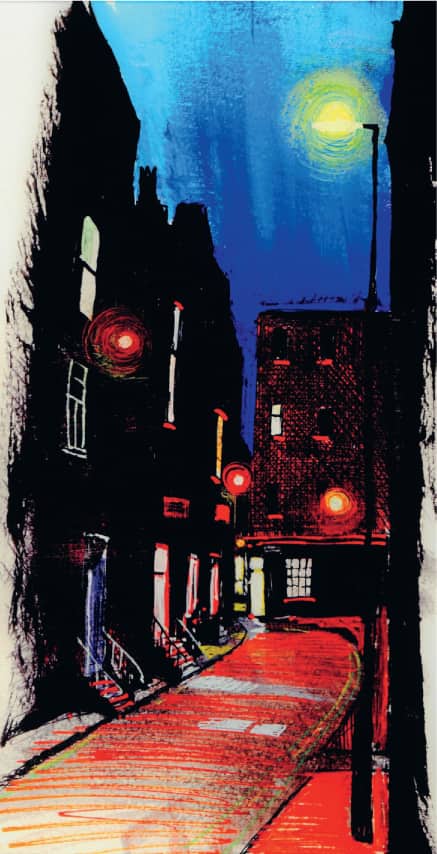
DAVID LOWTHER
Manchester Street by Night, United Kingdom
6" x 10" | 15.2 x 25.4 cm; marker, pen, and ink; 20 minutes
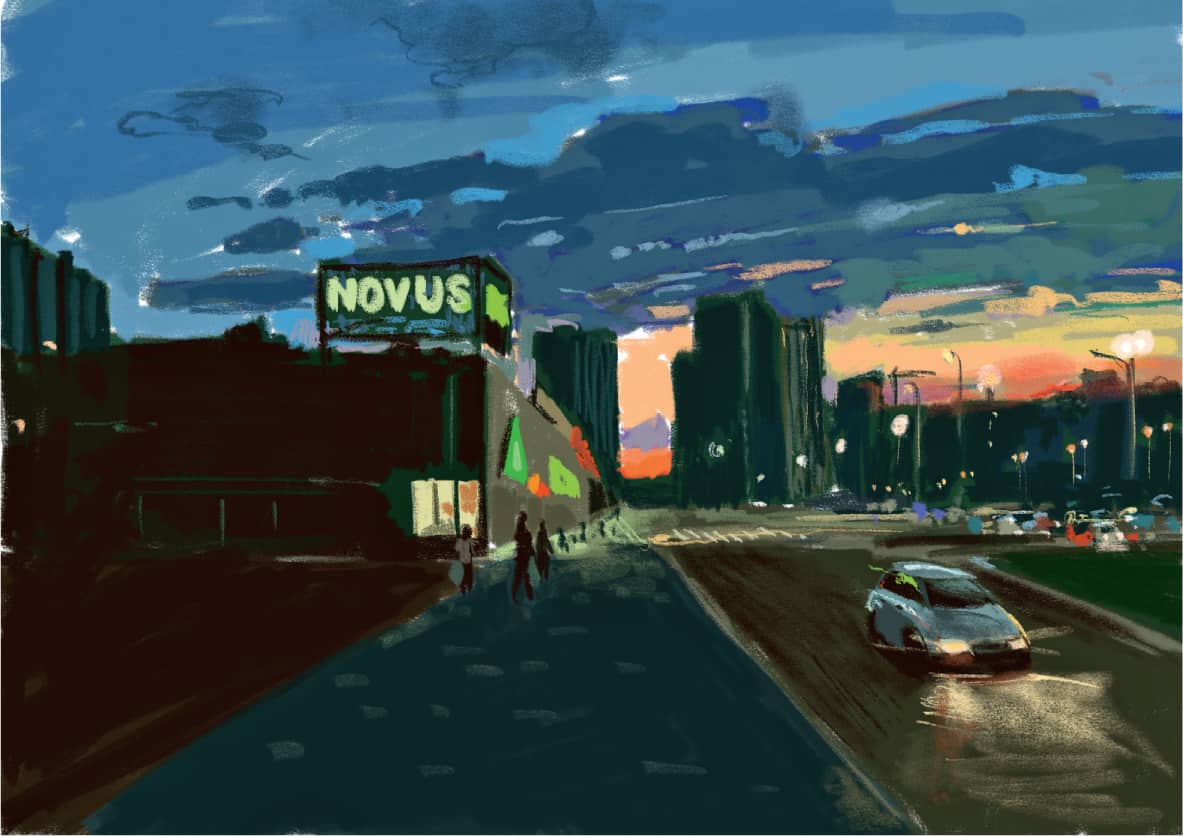
YEVHENNI OMETSYNKSYI
Retroville at Sunset, Kyiv, Ukraine
iPad, Apple Pencil, Procreate app
Notice that night scenes often contain multiple light sources. You can have the setting sun, a neon sign, glowing windows, and car headlights all in one view.
Multiple light sources may appear in daytime scenes, too, (below) especially in indoor scenes with light coming in from the windows. We have to consider the color of the light coming in from the windows, treat each window as its own light source, and consider the color of any light sources inside as well. With multiple light sources, we can also have multiple shadows from a single object.
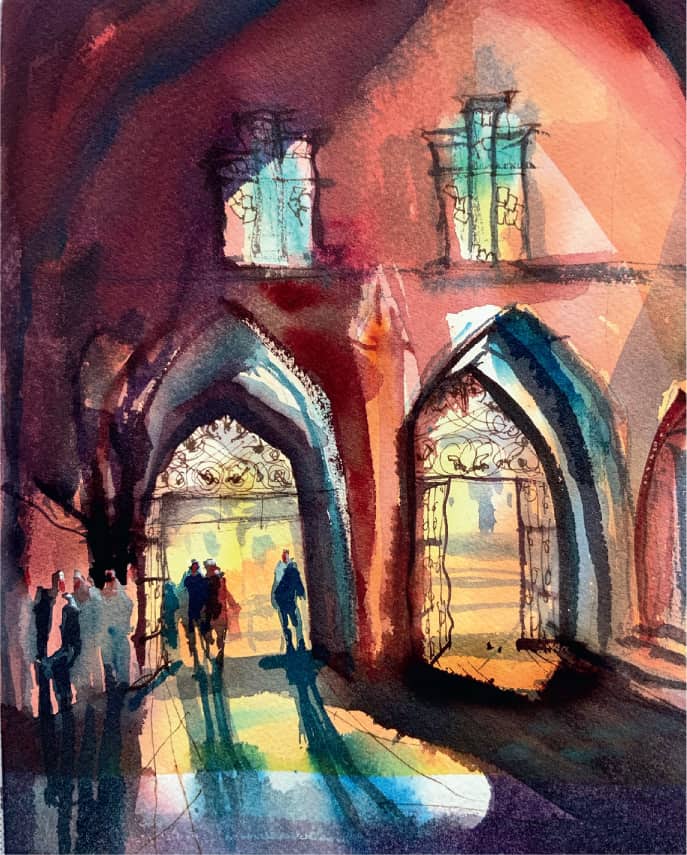
TINE KLEIN
Basel Town Hall, Basel, Switzerland
21" x 17" | 53.2 x 42.7 cm; watercolor and fountain pen; 40 minutes
“This is not a church, it is the town hall in Basel, it is a cathedral of democracy. The house’s wonderful construction is a red castle from 1500, it is so superb. There is so much to see, murals, statues and stonemasonry that I observed several times before I started to paint. The light inside of the castle wall is fundamentally different to the nearly Mediterranean light outside of the building. The specialty about this is, that it is so dark inside of the inner courtyard, that the powerful colors of the building only start to glow when there is a sun ray kissing the walls.” —Tine Klein
NIGHT SKIES
You may notice when painting after sunset that the sky is often not the darkest part of your view. Intuitively we want to drop a black sky into a night scene, but in many situations, this is contrary to what we see in front of us. Especially in big cities, light pollution can keep the sky lighter, while light sources closer to us can cast dark shadows. Pay attention to the color of the sky—maybe it is purple, or navy, or gray! What in your view touches the sky? Check for value; see if the edges of trees or buildings appear darker or lighter than the sky itself. Streetlights may be offering ambient lighting to the ground level of buildings, while the tops remain dark against a lighter sky. The lighting itself can sell a sketch as being a night view: the light pouring out from a store front, a darkened building façade. Simply putting a black sky into a sketch done during the day will likely still not read as nighttime.
Night sketches tend to be darker overall, which can be hard to get used to. It may mean the lightest parts of a sketch get darker than usual to keep the sketch cohesive.

PEDRO ALVES
Castle and Santa Maria Church, Torres Vedras, Portugal
10" x 6" | 25 x 15 cm; ink and watercolor; 50 minutes
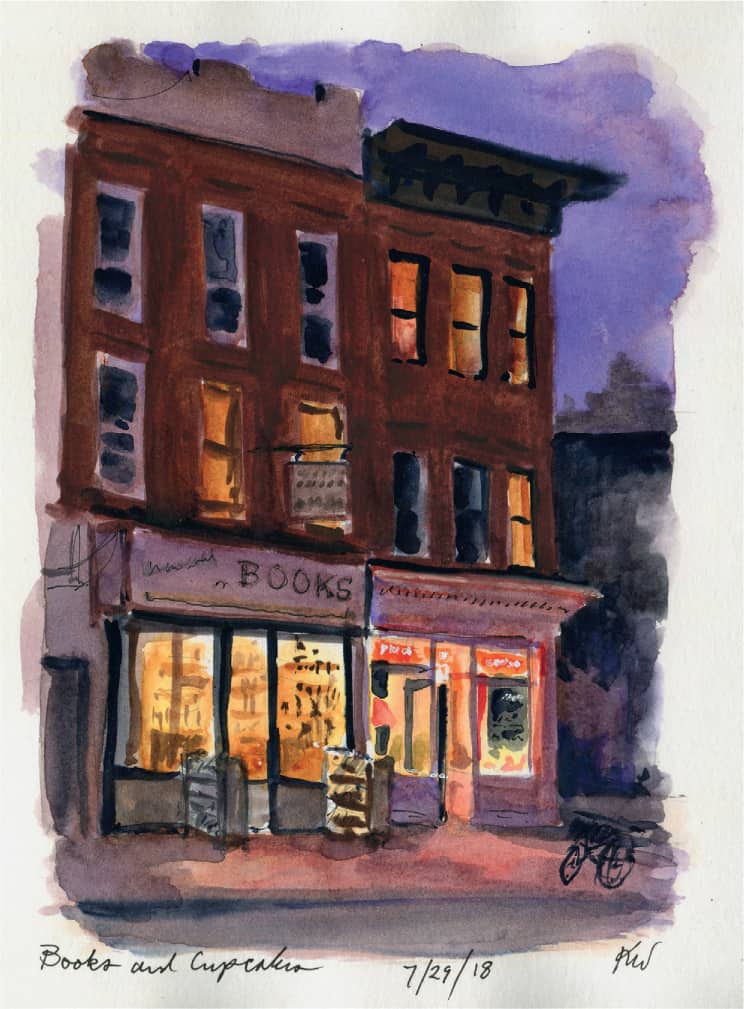
KATIE WOODWARD
Books and Cupcakes, Brooklyn, New York
5" x 7" | 12.7 x 17.8 cm; watercolor, graphite pencil, white Uni-ball Signo gel pen, Pigma Micron; 1 hour
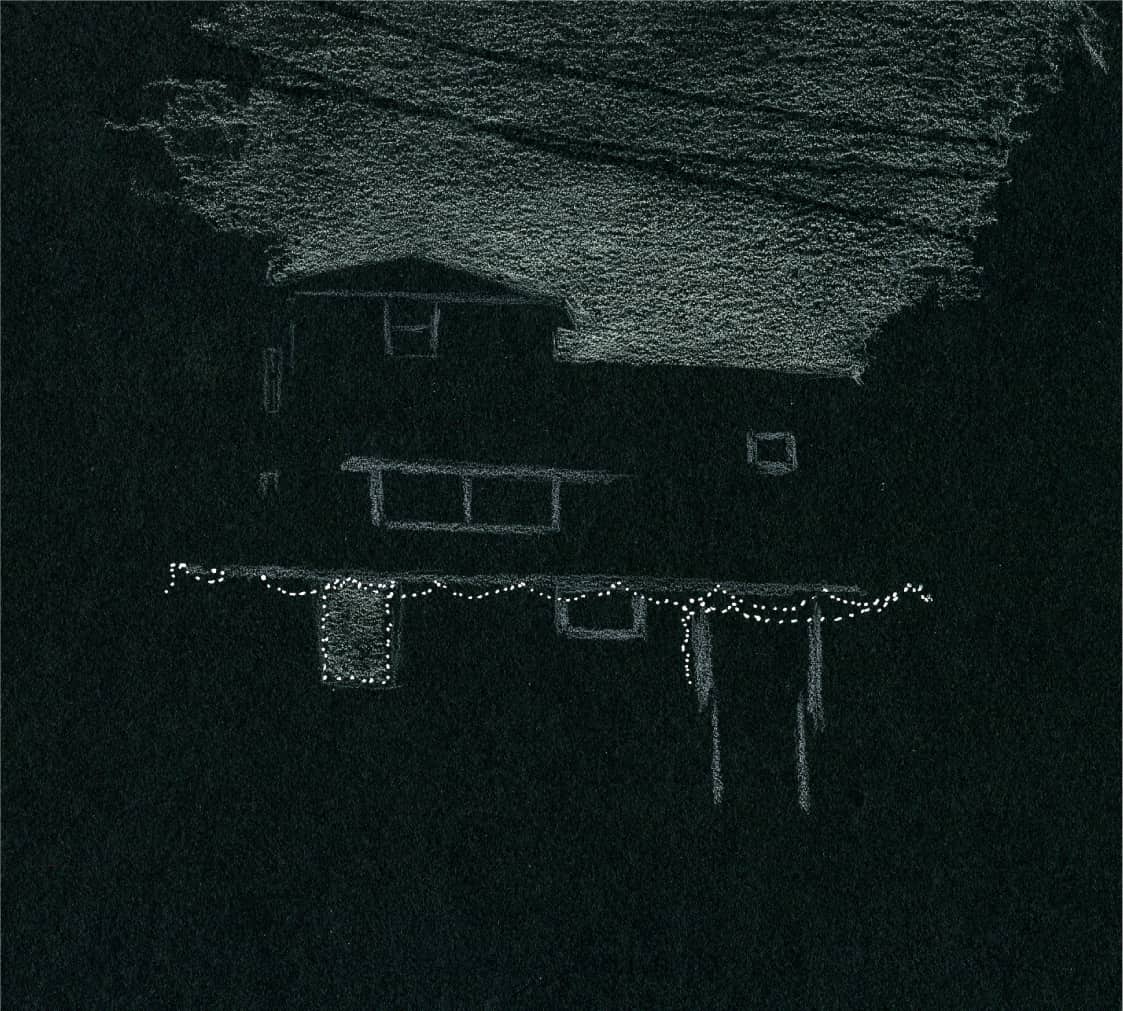
TINA KOYAMA
Predawn Fog
7" x 7" | 17.8 x 17.8 cm; colored pencils, black paper; 30 minutes
STREETLIGHTS
Oftentimes, our light source is the sun, or a lamp attached to a wall or ceiling. Streetlights are a fun but unusual light source, since we can see how they are affecting objects a full 360 degrees around them. They can cast a wide radius, hitting not only the street and walking paths they are meant to illuminate, but also surrounding trees, people, and buildings.
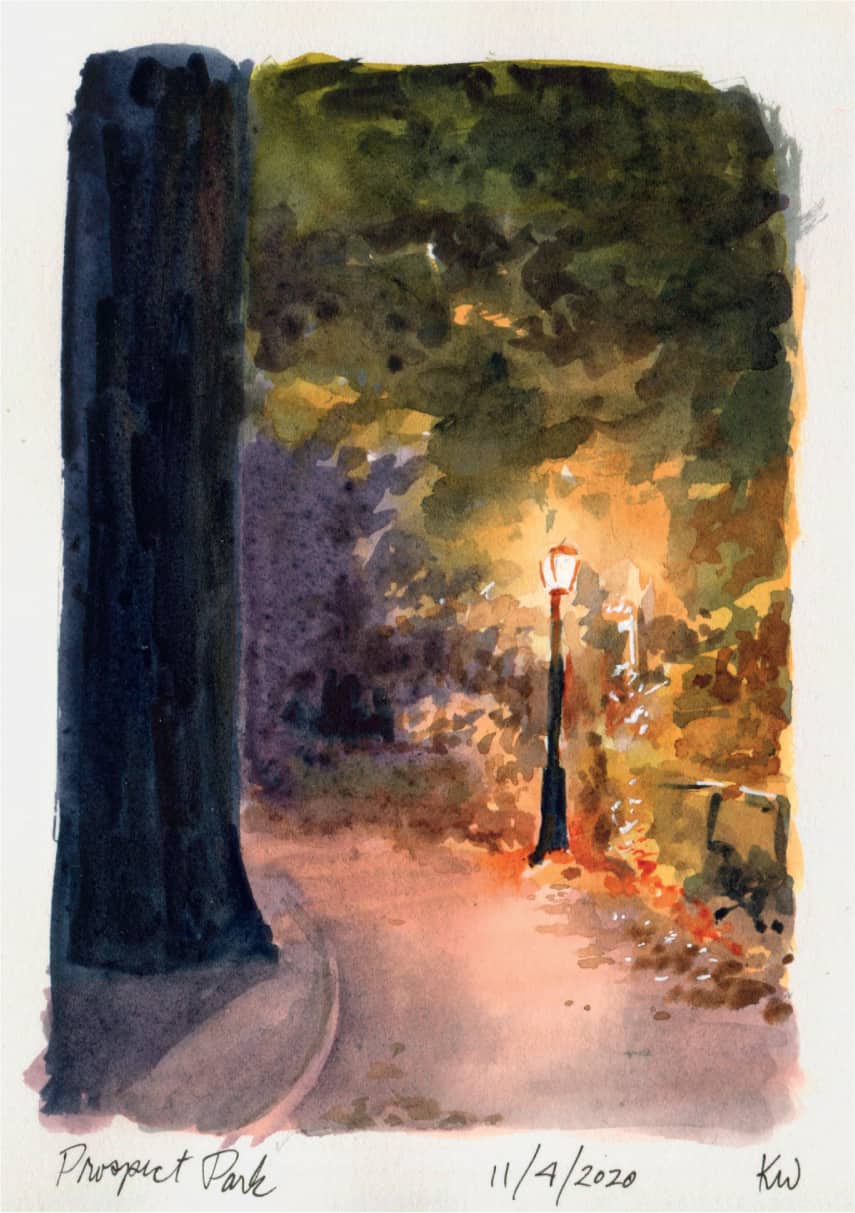
KATIE WOODWARD
Prospect Park, Brooklyn, New York
5" x 7" | 12.7 x 17.8 cm; watercolor, graphite pencil and Pigma Micron pen
Notice how the light hits the nearby foliage, and the shadow cast by the tree. I kept the top of the pole warmer and lighter than the bottom to add to the corona surrounding the lamp.

KATIE WOODWARD
Ponte Dom Luís, Porto, Portugal
8" x 10" | 20.3 x 25.4 cm; watercolor and graphite pencil
If viewing the lights up close, each streetlight may appear as a glowing orb, but they can affect a far-off sketch as well. While some buildings may have specifically focused architectural lighting, often the primary lighting hitting the faces of buildings at night is ambient lighting from streetlights! Think about looking at a far-off town; do you see the glow of the streets?
Gallery: Streetlights

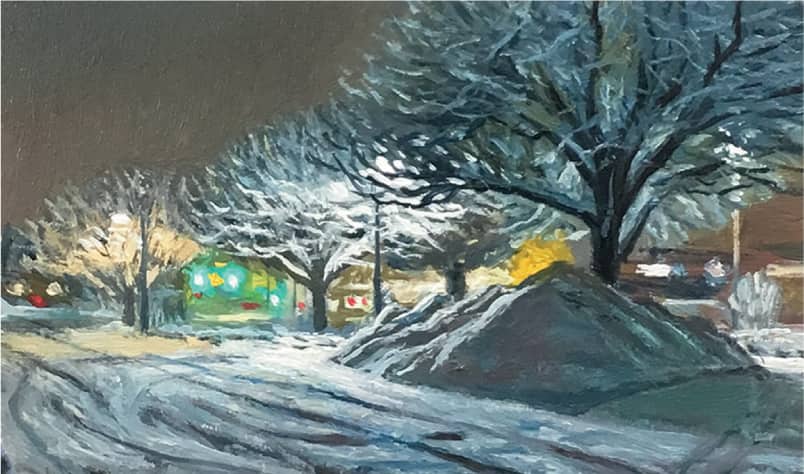
REMINGTON ROBINSON
Snowy Parking Lot Nocturne, Boulder, Colorado
1⅞" x 3⅛" | 4.64 x 7.94 cm; oil on wood panel
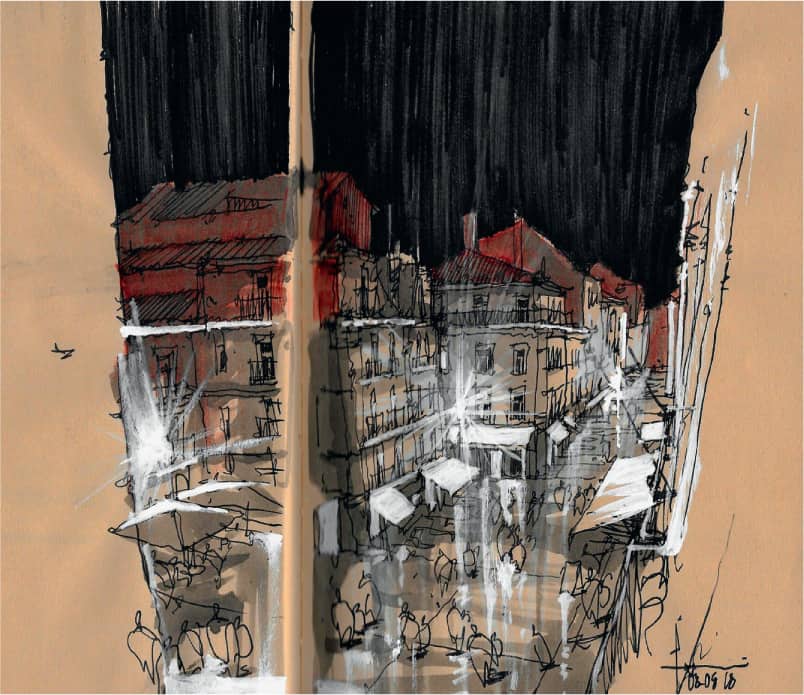
PEDRO ALVES
Portas de Santo Antão Street, Lisbon, Portugal
7½" x 8⅓" | 19 x 21cm; toned paper, watercolor, ink, markers, white acrylic; 35 minutes

PEDRO ALVES
Ramp Ponte de Lima, Ponte de Lima, Portugal
12" x 8" | 30 x 20 cm; watercolor, ink, white acrylic; 80 minutes
NEON
Neon offers a very specific challenge: it can be the brightest light in a view, but often that light is a very high chroma color. To get a high chroma red, for example, this usually means we want to use a pigment at full strength. The problem with doing this with neon is that the neon can appear much darker than it should be since a high chroma red is also dark in value. Suddenly, the values in the sketch are thrown off and instead of having the desired glow, the neon becomes harder to see. By paying attention to the balance of color and value, we can combat this in a few ways.
- • It’s all relative! Make the surroundings darker so the neon is lighter by comparison.
- • Leave the neon itself white (or, add the white back in with gouache or white gel pen) and make the glow around the light the appropriate color.
- • Add the color of the neon to surfaces being hit by the light, while leaving the light itself a bright white. It gives the viewer the impression that the light coming off the white object is that color. You can make an artistic decision on how much of that color to include, if you want to portray it as a huge, all-encompassing glow, or if the light only touches the closest objects.
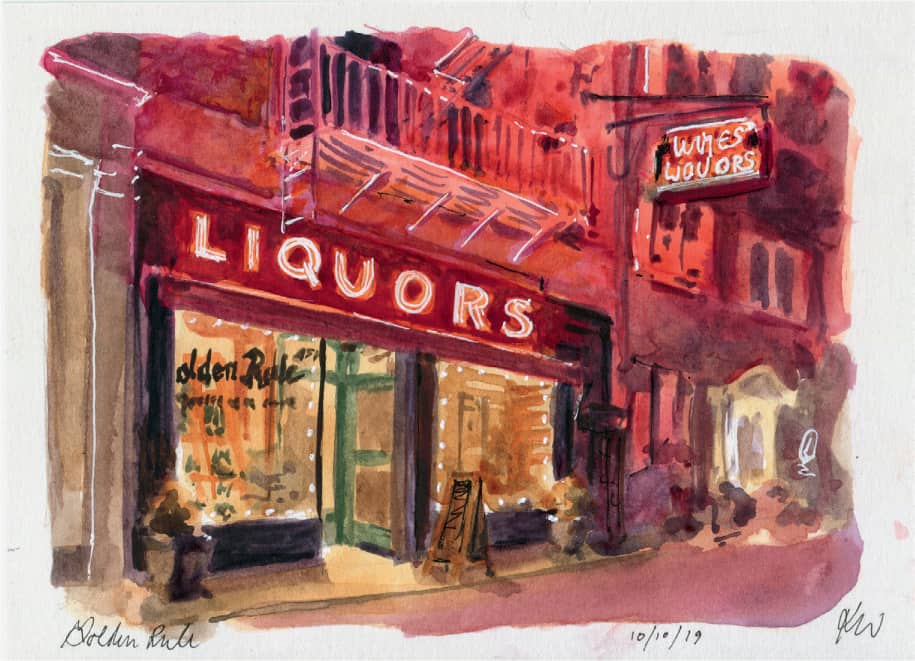
KATIE WOODWARD
Golden Rule Liquors, New York City
5" x 7" | 12.7 x 17.8 cm; watercolor, graphite pencil, white Signo gel pen, Pigma Micron pen; 2 hours
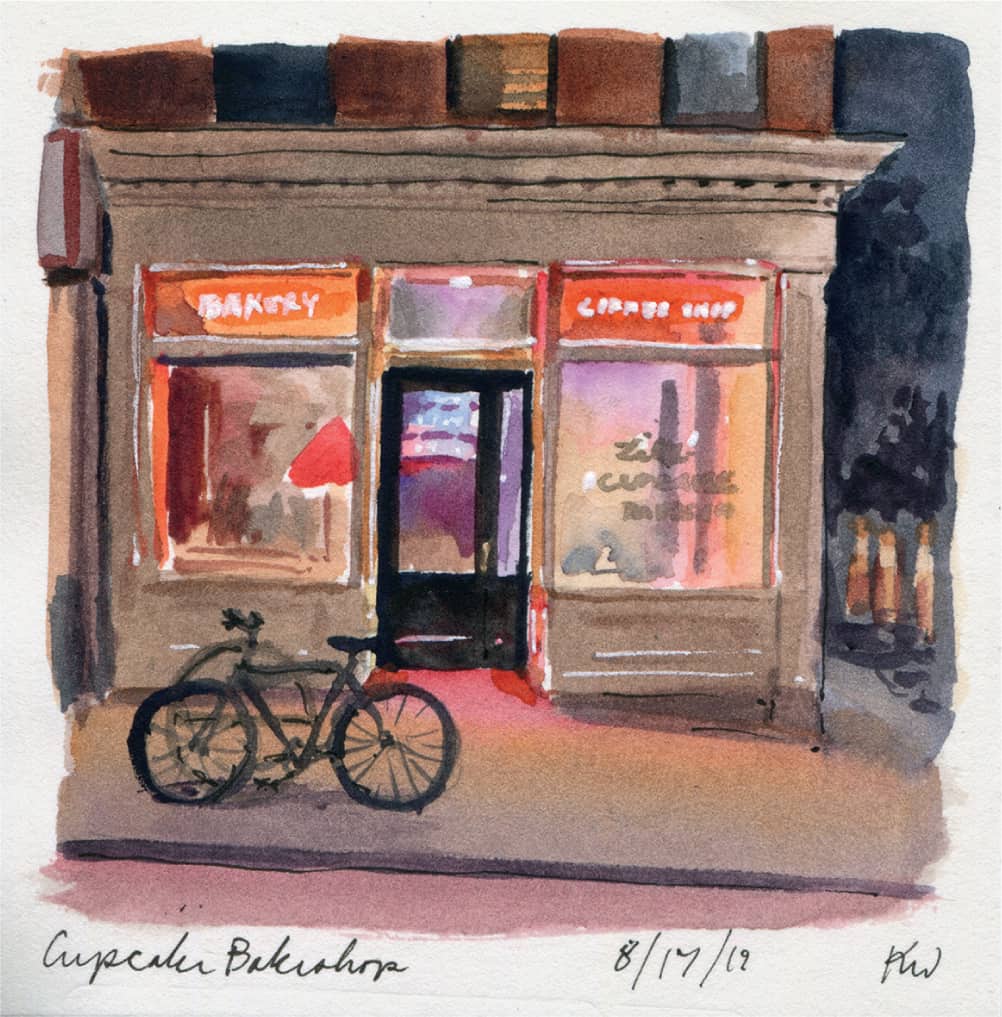
KATIE WOODWARD
Cupcake Bakeshop, Brooklyn, New York
4" x 4" | 10.2 x 10.2 cm; watercolor, graphite pencil, white Signo gel pen; 45 minutes
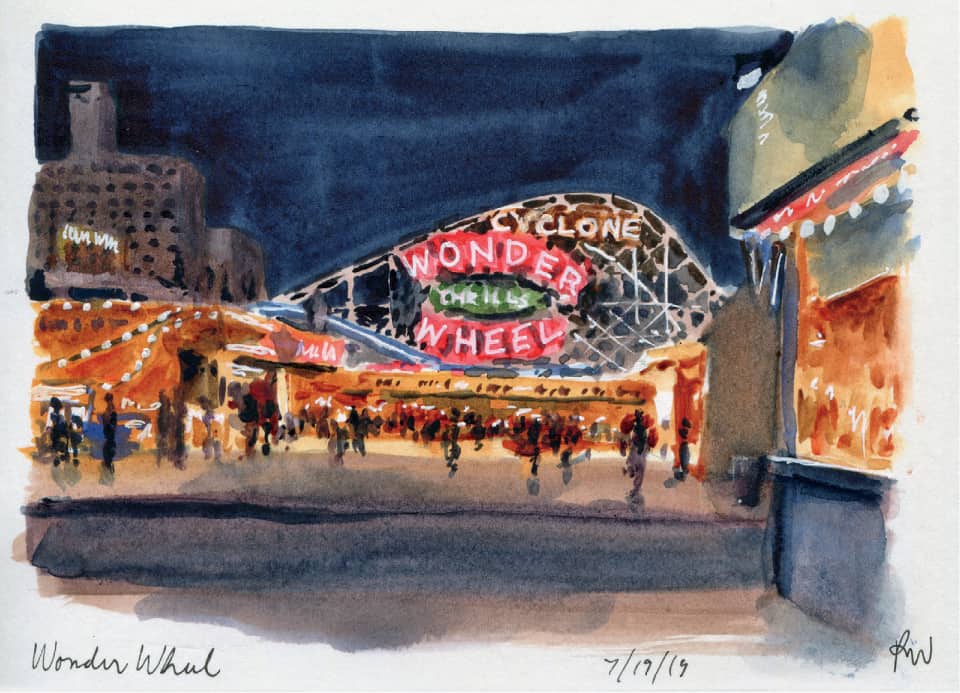
KATIE WOODWARD
Wonder Wheel, Coney Island, New York
5" x 7" | 12.7 x 17.8 cm; watercolor, graphite pencil, white Signo gel pen, Pigma Micron pen; 1½ hours
Gallery: Neon

KATIE WOODWARD
NYHC Tattoos, New York City
5" x 7" | 12.7 x 17.8 cm; watercolor, graphite pencil, white Signo gel pen
This awning was tricky, as it is catching light on the underside from the inside of the store, as well as from the neon on the window, while the top of the awning is also being lit by streetlights and ambient light. By giving the neon a tiny halo of its color and using pink and purple on the objects the light is hitting, it gives the impression of a tiny glow without being too much (especially since so much of the scene was being hit with ambient light and light from inside.) Note, too, the shadow of the awning supports visible as they are being backlit by the light from the window and door.
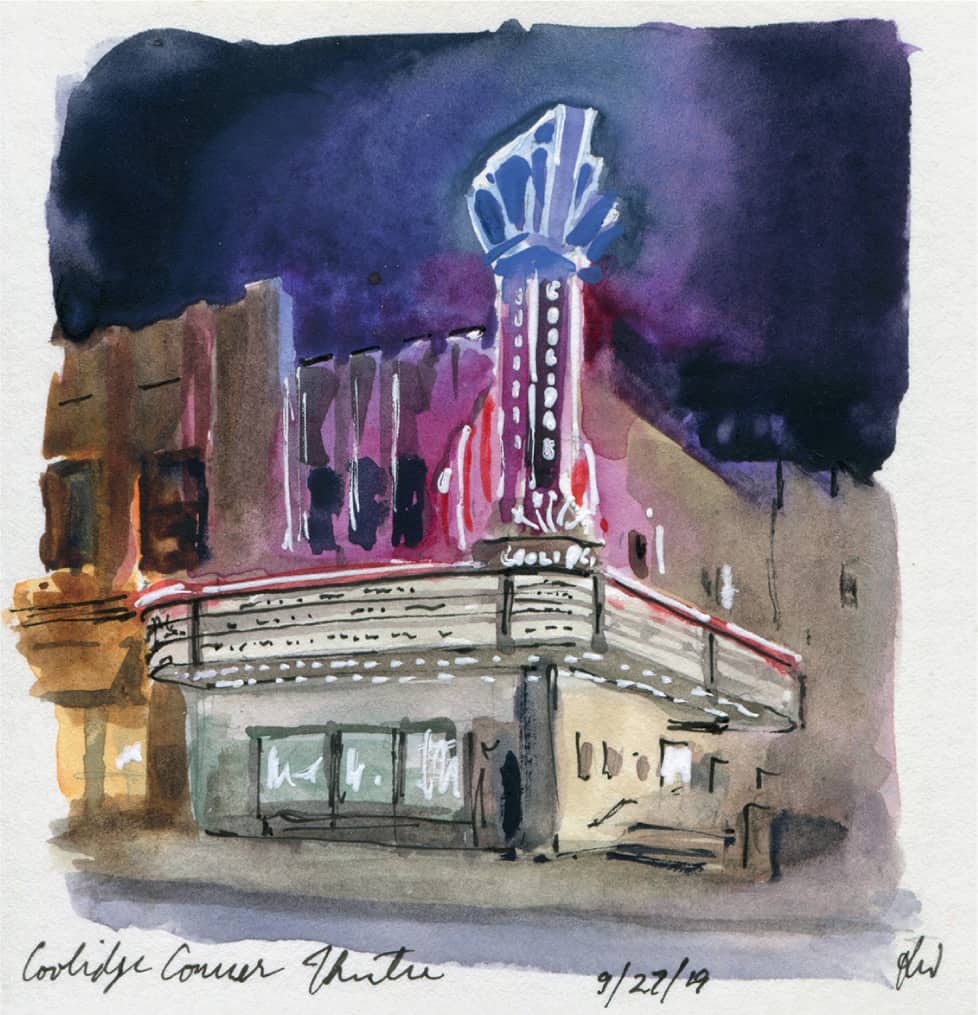
KATIE WOODWARD
Coolidge Corner Theatre, Boston, Massachusetts
4" x 4" | 10.2 x 10.2 cm; watercolor, graphite pencil, white Signo gel pen, Pigma Micron pen; 30 minutes
Here, to create the look of blue and purple neon, I used white for the lettering and blue and pink to show the light emanating off the sign, obscuring the sky. Notice the lighter, more blue and purple color in the sky around the light, while the sky gets darker farther away, giving it a kind of corona.

KATIE WOODWARD
Reading Terminal Market, Philadelphia, Pennsylvania
2" x 6" | 5 x 15.2 cm; watercolor, graphite pencil, white Signo gel pen, Pigma Micron pen; 30 minutes
In the case of this sign, taken out of context, I made sure to do the letters and neon in white, the surrounding area in the color of the neon, and used gray to make the neon color pop even more by comparison. Sketching it close-up gave me the opportunity to add in the dark sections of tubing connecting letters, which punctuates the bright neon.
SPECIAL LIGHTING
Lighting at a concert or sporting event can require a combination of techniques. The lighting may be bright white stadium lights, or bold, colorful theatrical lighting. We can use some of the same principals used for night sketching in these instances, but always want to start by locating where the light is coming from. We may see multiple light sources, with other parts of the scene falling into relative darkness. Often, we will observe one central area being lit.
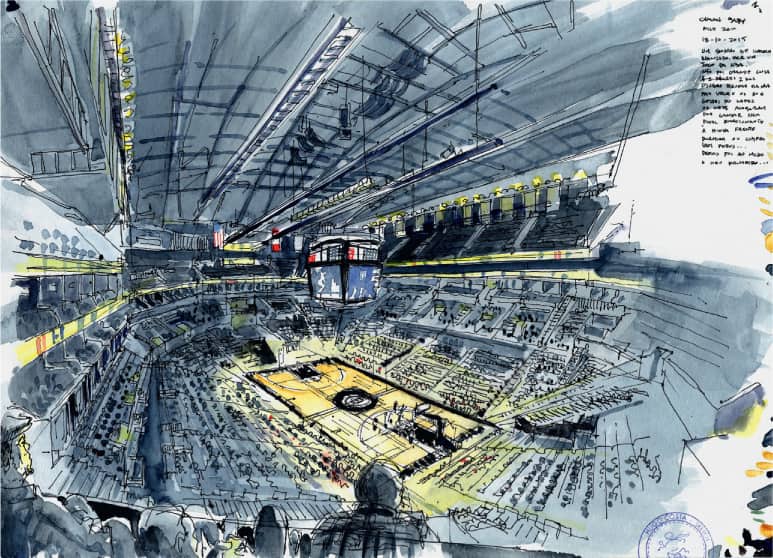
HUGO COSTA
Nets vs Sixers, Brooklyn, New York
11¾" x 16½" | 29.7 x 42 cm; Rollerball pen and watercolor; 2 hours
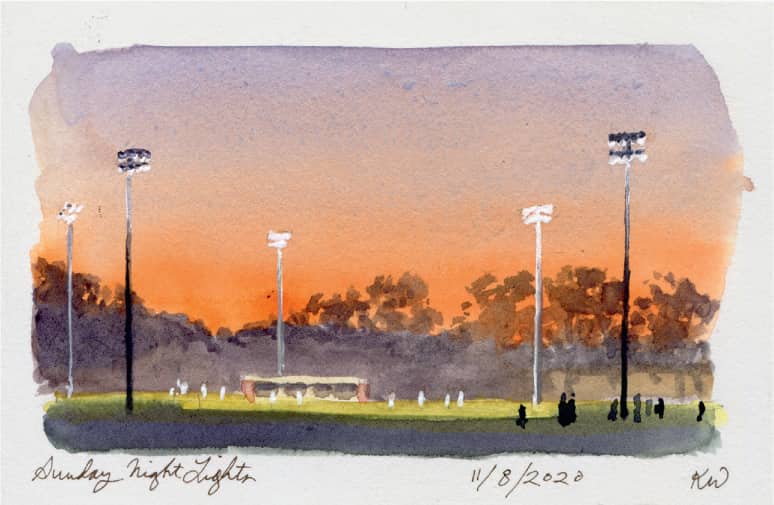
KATIE WOODWARD
Sunday Night Lights, Brooklyn, New York
4" x 6" | 10.2 x 15.2 cm; watercolor, white Signo gel pen, Pigma Micron pen; 30 minutes
Observation Checklist
 Find each light source and see what direction it is pointed in.
Find each light source and see what direction it is pointed in.
 What color is each light source?
What color is each light source?
 Is ambient light hitting anything else in the scene? (Consider a staged play: the lights are focused on stage, but the first few rows of audience members may be visible as light from the stage bounces off and illuminates them.)
Is ambient light hitting anything else in the scene? (Consider a staged play: the lights are focused on stage, but the first few rows of audience members may be visible as light from the stage bounces off and illuminates them.)
 Do you see multiple shadows coming off one object?
Do you see multiple shadows coming off one object?
